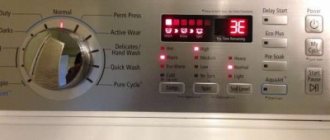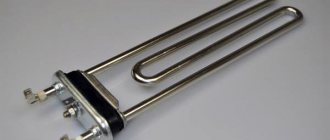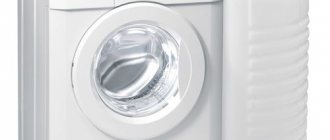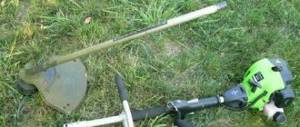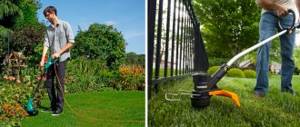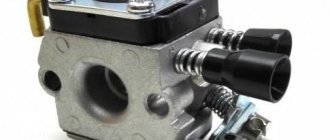Proper first start-up and running-in of the lawn mower are very important steps when starting to use a new tool. On the one hand, they allow you to preserve the service life of a gasoline engine, as specified by the manufacturer, since at this stage the grinding in of moving components and parts occurs. On the other hand, the first necessary skills of working with a trimmer are acquired, if we are talking about the first tool in life.
Inspection of the lawn mower gearbox and its lubrication
Before starting a gasoline trimmer, the gearbox must be checked on a regular basis. The lack of lubrication or a small amount of it increases the friction of the gear transmission of the gearbox, which operates at fairly high speeds. As a result, overheating of the gears occurs. The brush cutter gearbox fails. Regular inspection helps prevent such damage from occurring during operation.
If, before starting the gasoline scythe, an insufficient amount of lubricant in the gearbox or its absence is detected, “LITOL” is placed in the housing. To do this, you need to unscrew the screw on the bend of the gear housing and spray in 1-2 ml of LITOL.
When working with a gasoline trimmer for a long time, add lubricant to the boom gearbox every 8-10 hours.
Where to begin?
The correctness of the first launch largely determines how the gas braid will manifest itself during subsequent operation. Errors may shorten the life of the device. The fact is that after starting, the moving mechanisms of the working apparatus will rub against each other. Additionally, skills in using a trimmer are developed. This is very important when working with such equipment for the first time.
They start by examining the gearbox and the quality of its lubricant coating. Then prepare the fuel mixture according to the instructions.
When noting the lack of oil or its absence, you must add a portion of Litol. The procedure is very simple: unscrew the screw located on the bend of the gearbox housing. 1-2 ml of oil is added through the empty channel using a technical syringe. In daily work with the trimmer, the rod gearbox should be lubricated once every 8-10 hours.
But starting the hedge trimmer is not limited to filling it with oil.
Two-stroke engines require a flammable mixture of two-stroke oil and gasoline. It is prepared in the proportions specified in the tool manual or on the lubricant label. Fuel preparation should be done little by little so that it is enough for only one haircut. Fuel supply should be placed in the following containers:
- Plastic cans;
- Glassware;
- Metal containers
It is recommended to take the oil using a medical syringe. This will allow you to stick to your dosage more accurately. Sometimes another question arises. The tool manufacturer and the engine oil manufacturer specify different fuel mixture ratios, making it difficult to determine which areas to follow.
READ Replacing the Starter Spring of a Petrol Mower
After testing and filling the fuel mixture, the following manipulations must be performed:
- Place the trimmer on a flat surface;
- Move the lever to the closed position;
- Inject fuel into the carburetor;
- Start the ignition system;
- Pull the starter cord in a smooth motion, waiting for resistance;
- Immediately after this, do 3 or 4 strong jerks;
- Once the engine starts, open the shutter.
Preparing the correct fuel mixture
Before you start running in a new lawnmower engine, you also need to properly prepare the fuel mixture. As is known for two-stroke engines, it is prepared from special two-stroke oil and gasoline, taken in certain ratios. You can find out the proportions from the instructions supplied with the tool or on the lubricant label. From the instructions you will also learn the recommended type of fuel, as well as the recommended type of engine oil.
Prepare fuel in small quantities, enough for one mowing of grass. Use special plastic canisters or separate glass or metal containers for fuel. It is best to draw the oil with a medical syringe.
When getting ready to test out a new lawn mower, many are faced with the problem of preparing the fuel mixture. And the reason for this is discrepancies in the tool manufacturer’s instructions and in the motor oil manufacturer’s instructions. The first ones recommend a proportion of 1:25. The second recommend 1:50. Who to believe? How to proceed?
According to experts, if manufacturers write a ratio of 1:25 or 1:30 in the instructions for a brush cutter, then most likely it is either a cheap tool with poor cooling, or the manufacturer does not know what kind of oil, the consumer will add. But here you need to understand that excess lubricant does not have the best effect on the performance of the trimmer. Excess oil does not burn out completely when the engine is running. It cokes and clogs the cylinder and piston.
What to do in this situation when running in a new tool? The ideal option would be to purchase exactly the oil recommended by the manufacturer of the lawn mower. In the case of run-in engines, when it is not possible to purchase the recommended oil, it is best to purchase a good Husqvarna two-stroke oil for the same name gas-powered tool. It's not cheap, but it lasts a long time. It must be mixed as written in the instructions on the can.
Remember, it is best to use the proportion provided by the oil manufacturer. But whether the proportion written on the braid is appropriate is better to find out through experiment. If, with the proportion recommended by the trimmer manufacturer, the engine is snotty with oil and smudges are visible on it, then the proportion needs to be increased.
Starting diesel and gasoline engines
Engine failure occurs not only after purchasing new equipment, but also when installing a new engine, after major repairs, modernization or replacement of individual components of a walk-behind tractor (motor-cultivator).
Before starting the procedure, it is necessary to check the correctness and quality of assembly of the equipment, the fastening of all connecting bolts, and the availability of the necessary lubricants. The further algorithm of actions is as follows:
- Pour the required amount of oil into the crankcase and check its level using a probe.
- Add the required amount of fuel (A92 gasoline or diesel, depending on engine type) to the fuel tank.
- Check the connection of the oil level sensor to the relay.
- Open the fuel tank valve.
- Turn on the engine starter several times without paying attention to the ignition. On a diesel engine, the decompressor must be turned on.
- Open the air valve on the gasoline carburetor.
- Start the engine and close the shutter when it is warm.
After this you can start working on the engine. In the first stage, it is recommended to start at low speed, gradually and gradually increasing it to slightly above average. In this case, it is necessary to work through all the gears of the walk-behind tractor in turn for 1-2 hours. This will allow you to check not only the engine, but also the gearbox of the unit.
The second stage involves cultivating, plowing the soil and transporting small loads (up to 200 kg). At this stage, it is very important not to exceed the permissible load on the walk-behind tractor specified in the operating instructions. Example: if the maximum tillage depth indicated in the passport is 30 cm, then when starting the engine, the immersion depth of the cutter should not exceed 15 cm.
Starting a diesel engine is not fundamentally different from a gas engine, but it is important to remember that any engine does not like to idle for long periods at high speeds. This is a very common mistake that leads to serious consequences, including major engine repairs. For different walk-behind tractors, the breakdown process can take up to 10 hours.
READ Tuning the Carburetor of a Chinese Brushcutter
After the engine and cylinder block fail, the oil in the crankcase and gearbox must be replaced with new oil, based on the recommendations in the operating instructions.
Source
Braids, they are trimmers, are popular. These budget machines can be used in summer cottages, private farms, farms and public utilities. However, the practicality of such devices can only be appreciated by those who can start their work correctly.
First start of the trimmer
When everything is checked and the prepared fuel mixture is poured into the tank, the moment comes for the first start of the trimmer before running it in. To do this, you need to perform the following manipulations:
- Place the brush cutter on a flat horizontal surface;
- Move the choke control lever to the closed position;
- We pump fuel into the carburetor with several pumps of primer;
- Turn on the ignition switch;
- Smoothly pull out the starter cord until you feel resistance;
- Then make 3...4 sharp jerks with the cord until the lawn mower starts;
- After starting, open the air damper.
If the lawn mower does not start or stalls the first time, slightly open the air duct damper on the carburetor and try starting again.
How to run in parts?
The described launch method is quite suitable even for Chinese technologies. But sometimes it is impossible to start the first time or the trimmer stops immediately. In this case, similar manipulations are performed when closing the air duct valve. If then nothing works, you need to contact a specialist. If the system is working correctly, never start the device immediately.
READ Running in the Husqvarna Trimmer
First, the engine should be idled for 5 minutes. Important: If the instructions indicate a different time, you must follow their instructions. During warming up, it is necessary to adjust the air supply. By setting the choke lever to different positions, they ensure that the cutting part does not move. After waiting for it to warm up, open the damper completely and set the power to 50% of the maximum.
The lever is held in this position for 20.30 seconds. Lowering the gas to minimum, let the braid work for 30-40 seconds. Then they set the power to 20% and wait 10-15 minutes. After this, the engine is turned off and left alone for ¼ hour. When the trimmer cools down, the engine starts in accordance with the scheme already described, but first the damper opens.
Prolonged retention of gas should be avoided as poorly machined parts may be damaged. Prolonged idling is also contraindicated. This will cause overheating. This shuts down the engine and then you need to start the transmission. This procedure is performed in an open area where soft, fresh grass grows. It is mowed for 5.10 minutes without a break, periodically treated with gases at a power of 50-75%.
After such a session, mowing stops for 20 or 25 minutes. Usually 3-4 cycles are enough to keep the trimmer working properly for many years. Most often they try to start the device before the first refueling is completed.
See the following video for the features of the hedge trimmer.
Source
Getting the hedge trimmer up and running correctly are very important steps when starting up a new tool. On the one hand, they allow you to save the service life of a gasoline engine, as set by the manufacturer, since at this stage the moving units and parts are crushed. On the other hand, the first necessary skills for working with a trimmer are acquired when we talk about the first tool in my life.
- Preparing to use the hedge trimmer for the first time
- Inspection and lubrication of the gearbox
- Preparing the correct fuel mixture
- First trigger
- Getting Started with Starting Petrol Brushes
Let's start running in the lawn mower
After starting, do not rush to immediately break in the trimmer. Allow the engine to warm up at idle speed for 5 minutes. While warming up, adjust the air supply using the air damper lever so that the spool with fishing line or knife does not rotate. As soon as the tool has warmed up, we fully open the air supply by moving the corresponding lever to the “ON” position and squeeze the gas trigger 1/2 and hold for 20...30 seconds. Then we let off the gas and let the trimmer work for XX 30..40 seconds. We continue in this mode for 10…15 minutes. Then turn it off and let it rest for 15...20 minutes.
Having cooled the lawn mower, we continue to run in the engine according to the previous scheme. You need to start the trimmer when it’s hot, with the air damper already open. Try not to hold the gas for a long time, since the moving parts of the tool are only rubbing against each other. And do not let the engine idle for too long, as it may overheat.
The next stage is running in the gas scythe gearbox. To do this, you need to choose an area with soft young grass. We mow for 5...10 minutes with throttle adjustments at 1/2...2/3 of full throttle. Afterwards we take a break for 20…25 minutes. We repeat the cycle 3…4 times.
In general, running in the lawn mower according to the described algorithm is carried out until the fuel mixture in the tank is completely exhausted. After which the tool is ready for long-term work. During operation, monitor the temperature conditions of the gearbox and motor. They should not overheat.
Running in the New Gasoline Trimmer
1st start-up and running-in of the lawn mower
Proper first start-up and running-in of the lawn mower are very important steps in first operating a new tool. On the one hand, they allow you to preserve the service life gasoline engine, as specified by the manufacturer, because at this step the grinding in of moving components and parts occurs. On the other hand, the first necessary abilities to work with a trimmer are acquired, if we are talking about the first tool in life.
Preparing for the first start of the lawn mower
Before you start the lawn mower for the first time, you need to perform a number of sequential actions:
- Inspect the gearbox and lubricate it;
- Prepare the correct fuel mixture.
We advise you to do them not only when purchasing a new trimmer, but also when preparing an old tool for the new season after storage.
Inspection of the lawn mower gearbox and its lubrication
Before starting a gasoline trimmer, the gearbox must be checked on a permanent basis. The lack of lubrication or a small amount of it increases the friction of the gear transmission of the gearbox, which operates at fairly high speeds. As a result, the gears also overheat. The brush cutter gearbox fails. Constant inspection helps prevent the occurrence of such damage during use.
If, before starting the gasoline scythe, it is detected that there is an insufficient amount of lubricant in the gearbox or its absence, “LITOL” is placed in the housing. To do this, you need to unscrew the screw on the bend of the gear housing and inject “LITOL” in an amount of 1-2 ml.
When working with a gasoline trimmer for a long time, add lubricant to the boom gearbox every 8-10 hours.
Preparing the correct fuel mixture
Before you start running in the new lawnmower engine, you also need to properly prepare the fuel mixture. As is clear for two-stroke engines, it is prepared from special two-stroke oil and gasoline, taken in certain proportions. You can find out the proportions from the annotation included with the tool or on the lubricant label. From the annotation you will also find out the recommended type of fuel, as well as the recommended type of engine oil.
READ How to Clean the Trimmer Fuel Filter
Prepare fuel in small quantities, sufficient for the 1st mowing of the grass. Use special plastic cans or separate glass or metal containers for fuel. It is best the oil with a syringe.
When getting ready to test out the newest lawn mower, many are faced with a problem in making the fuel mixture. And the reason for this is the discrepancy in the tool manufacturer's instructions and in the motor oil manufacturer's instructions. The first ones recommend a proportion of 1:25. The second ones advise 1:50. Who to believe? How to proceed?
Running in a Chinese lawn mower and operating issues. Practice
I continue to share my first impressions of the Tatra brush cutter. In this video I will briefly talk about the first start.
First launch and running-in of the Tatra BCU-73 brushcutter
In this video we will point out the most common mistake when breaking in lawn mowers and chainsaws. Buy spare parts.
According to professionals, if manufacturers write a proportion of 1:25 or 1:30 in the annotation for a lawn mower, then most likely it is either a cheap tool with poor cooling, or the manufacturer does not know what kind of oil the consumer will add. But here you need to realize that excess lubricant does not have the best effect on the performance of the trimmer. Excess oil does not burn out one hundred percent when the engine is running. It cokes and clogs the cylinder and piston.
READ Trimmer Line What Material?
What to do in this situation when running in a new tool? The best option would be to purchase exactly the oil recommended by the manufacturer of the lawn mower. In the case of run-in engines, when it is not possible to purchase the recommended oil, it is best a good Husqvarna two-stroke oil for the same name gas-powered tool. It is expensive, but it lasts a long time. You need to stir it because it says in the instructions on the can.
Remember, it is best to use the proportion provided by the oil manufacturer. But whether the proportion written on the braid is appropriate is better to find out by experience. If, with the proportion recommended by the trimmer manufacturer, the engine snot with oil and smudges are visible on it, then the proportion must be increased.
First start of the trimmer
When everything has been tested and the prepared fuel mixture has been poured into the tank, the moment comes for the first start of the trimmer before running it in. To do this, you need to perform the following manipulations:
- Place the brush cutter on a flat, horizontal surface;
- Move the choke control lever to the closed position;
- We pump fuel into the carburetor with several pumps of primer;
- Turn on the ignition switch;
- Gently pull out the starter cord until you feel resistance;
- Then make 3...4 sharp jerks with the cord until the lawn mower starts;
- After starting, open the air damper.
If the lawn mower does not start or stalls the first time, slightly open the air duct damper on the carburetor and try to start it again.
READ How to Adjust Carburetor on Trimmer Video
Let's start running in the lawn mower
After starting, do not rush to immediately break in the trimmer. Let the engine warm up at idle for 5 minutes. While warming up, adjust the air supply using the air damper lever so that the spool with fishing line or knife does not spin. Once the instrument has warmed up, we open the air supply completely by moving the corresponding lever to the “ON” position and squeeze the gas trigger 1/2 and hold for 20...30 seconds. Later we release the gas and let the trimmer work for XX 3040 seconds. We continue in this mode for 10…15 minutes. Then turn it off and let it rest for 15...20 minutes.
Having cooled the lawn mower, we continue to run-in the engine according to the previous scheme. You need to start the trimmer in hot weather with the air damper already open. Try not to hold the gas for too long, because the moving parts of the tool are just rubbing against each other. And do not let the engine idle for a long time because it can overheat.
The next stage is running in the gas scythe gearbox. To do this, you need to choose an area with soft young grass. We mow for 5...10 minutes with throttle adjustments at 1/2...2/3 of full throttle. Afterwards we take a break for 20…25 minutes. We repeat the cycle 3…4 times.
In general, running in the lawn mower according to the described method is done until the fuel mixture in the tank is completely exhausted. After this, the tool is ready for long-term work. During operation, monitor the temperature conditions of the gearbox and motor. They should not overheat.
Source
Mow safety
What are the safety precautions when using a trimmer? There are several simple and clear points after which you can avoid dangerous situations and minimize the likelihood of injury:
- Do not use the trimmer in damp or humid weather (especially an electric trimmer);
- Dress before mowing your body to avoid damaging your skin with pieces of grass stems flying from the disc or fishing line at high speed;
- Keep a distance of 15 meters from other people and pay attention to signs that others may give;
- Using headphones or earplugs;
- Use an electric trimmer to make sure the extension cord is always behind you;
- Wear tight rubber boots that are easy to wash after work;
- Using gloves and safety glasses, avoid getting small stones into your eyes and respiratory tract;
- In case of injury, consult a doctor immediately.
Also, don't forget to look behind you if you suddenly encounter an obstacle in front or on the side. When plunging the barbell and blade into thick grass, be aware that there may be rocks, tree stumps, or berries (such as strawberries) in the area. Working with a trimmer requires discipline and attention, but once you understand the simple rules, it will become familiar, understandable and will bring only positive emotions from the results.
Source
We work in a gas trimmer
The most common use of mileage is in a lawn mower (gas trimmer). Breaking. This is engine operation at low speeds, without load. First you need to start the scythe and let it work. It is best to mow first with a line because mowing grass puts less stress on the engine than cutting hay or brush.
There is no need to develop the entire temporary resource when the engine is first started. After idling, it is best to mow the lawn for 10-15 minutes, then turn off the machine and let it cool slightly. Use the hedge trimmer carefully, without sudden movements, to avoid collisions with hard objects (stones). A stone impact can negatively affect the operation of nodes that have not yet been launched. In some cases, play, noise and hum appear during operation. This can easily be avoided if the trimmer is started correctly.
READ Texas Trimmer Doesn't Rev Up
